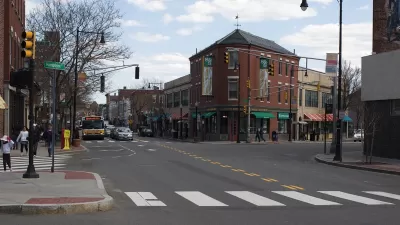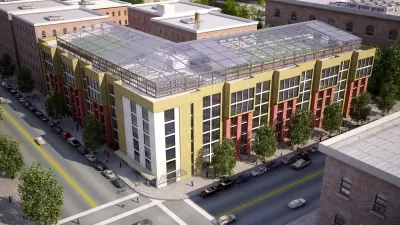After moving forward with parking and zoning reforms, the Berkeley City Council is also considering a new Affordable Housing Overlay on a model previously adopted in Cambridge, Massachusetts.

Berkeley is not resting after taking several significant steps toward planning reform in recent months—first by removing residential parking requirements in most parts of the city and then by voting to rescind single-family zoning.
Berkeley Councilmember Terry Taplin has also sponsored a 100% Affordable Housing Overlay, building on a model provided by a similar overlay approved by Cambridge, Massachusetts in October 2020.
Randy Shaw, who has written on the idea previously for Beyond Chron and in his book Generation Priced Out, details the proposal. Shaw is an obvious proponent of the Affordable Housing Overlay concept, calling it "the best strategy for high housing cost cities to reduce segregation."
How does an affordable housing overlay work? "Cambridge’s Affordable Housing Overlay permits greater height and density for ministerial approval for 100% Below Market-Rate housing developments." Those height and density bonuses "[increase] the availability of infill sites where nonprofit and public entities may otherwise be unable to compete with private developers," according to Shaw, who notes that numerous underutilized commercial parcels in Berkeley would become much more viable for affordable housing development under the proposed changes.
Councilmember Taplin's proposed overlay was scheduled for a hearing before the Berkeley City Council's Land Use Committee on March 4. The Joint Center for Housing Studies at Harvard University is hosting a free webinar on the subject of affordable housing overlays on March 11, exploring the possibility of this planning policy tool's expansion to yet more locations.
FULL STORY: Berkeley's Next Big Step: A 100% Affordable Housing Overlay

Alabama: Trump Terminates Settlements for Black Communities Harmed By Raw Sewage
Trump deemed the landmark civil rights agreement “illegal DEI and environmental justice policy.”

Planetizen Federal Action Tracker
A weekly monitor of how Trump’s orders and actions are impacting planners and planning in America.

The 120 Year Old Tiny Home Villages That Sheltered San Francisco’s Earthquake Refugees
More than a century ago, San Francisco mobilized to house thousands of residents displaced by the 1906 earthquake. Could their strategy offer a model for the present?

Ken Jennings Launches Transit Web Series
The Jeopardy champ wants you to ride public transit.

BLM To Rescind Public Lands Rule
The change will downgrade conservation, once again putting federal land at risk for mining and other extractive uses.

Indy Neighborhood Group Builds Temporary Multi-Use Path
Community members, aided in part by funding from the city, repurposed a vehicle lane to create a protected bike and pedestrian path for the summer season.
Urban Design for Planners 1: Software Tools
This six-course series explores essential urban design concepts using open source software and equips planners with the tools they need to participate fully in the urban design process.
Planning for Universal Design
Learn the tools for implementing Universal Design in planning regulations.
Clanton & Associates, Inc.
Jessamine County Fiscal Court
Institute for Housing and Urban Development Studies (IHS)
City of Grandview
Harvard GSD Executive Education
Toledo-Lucas County Plan Commissions
Salt Lake City
NYU Wagner Graduate School of Public Service





























